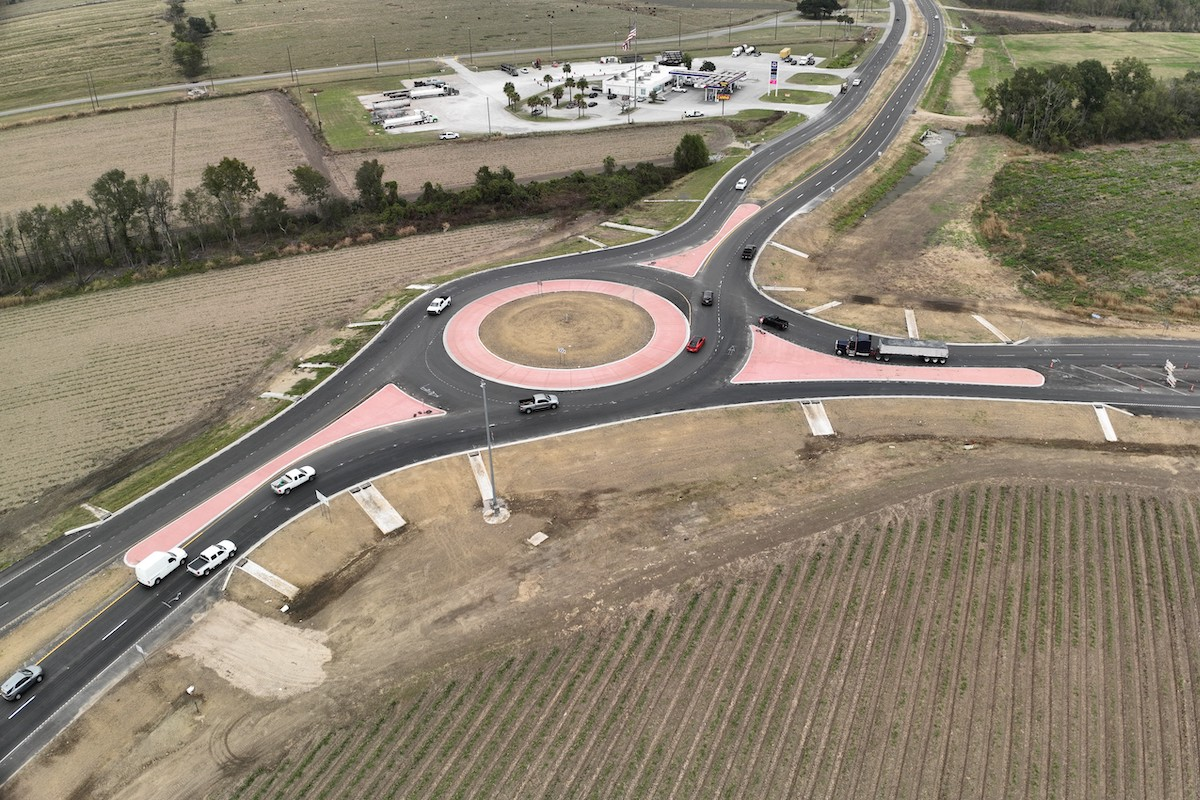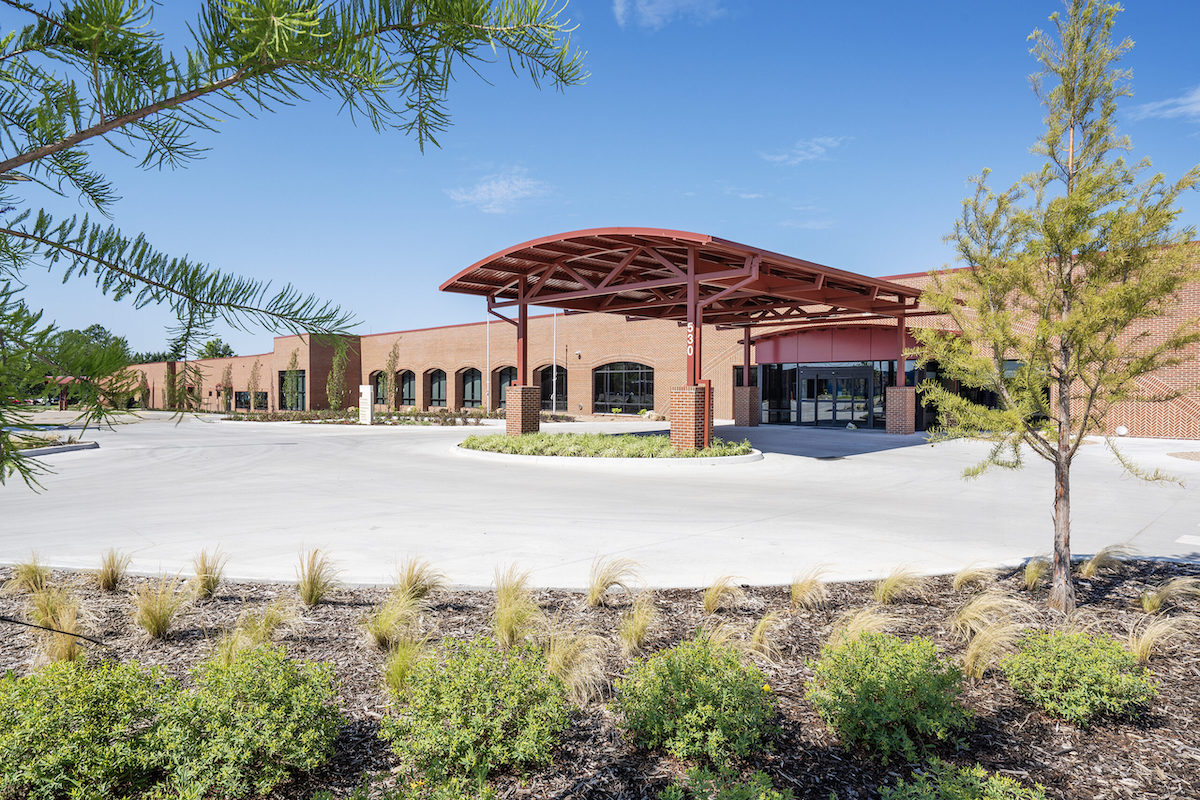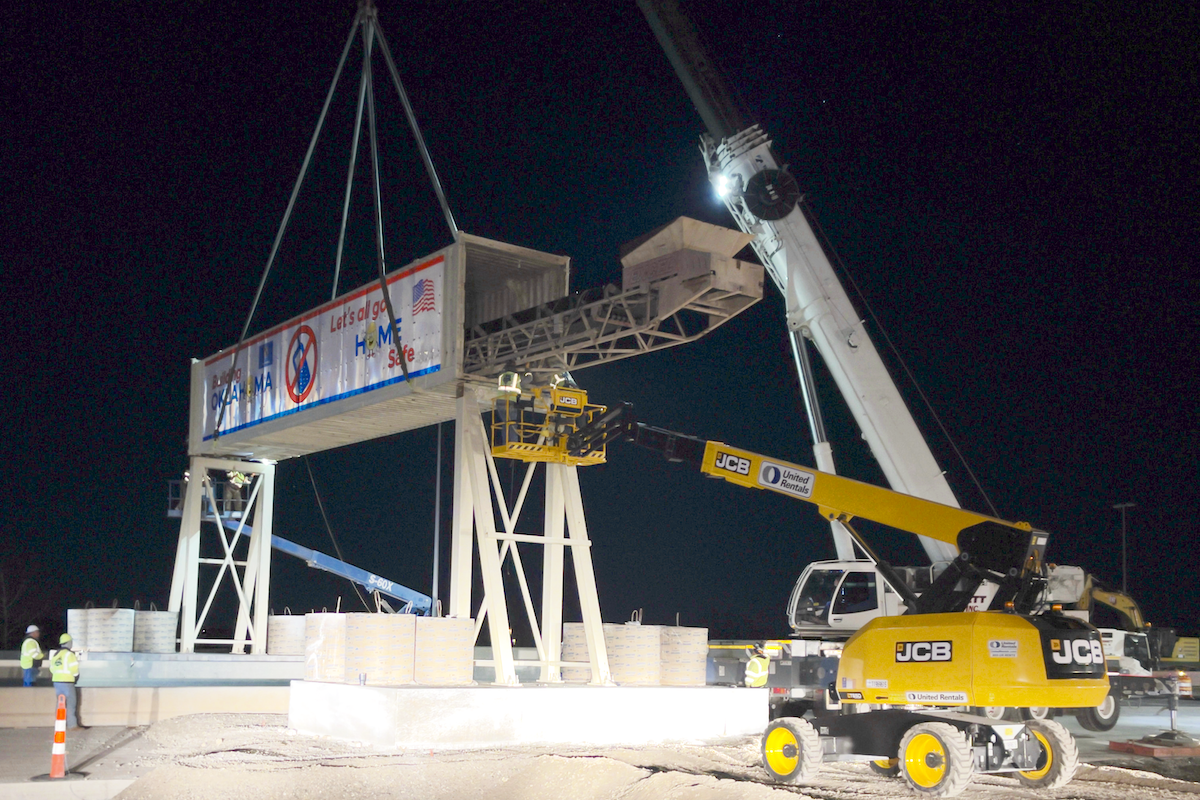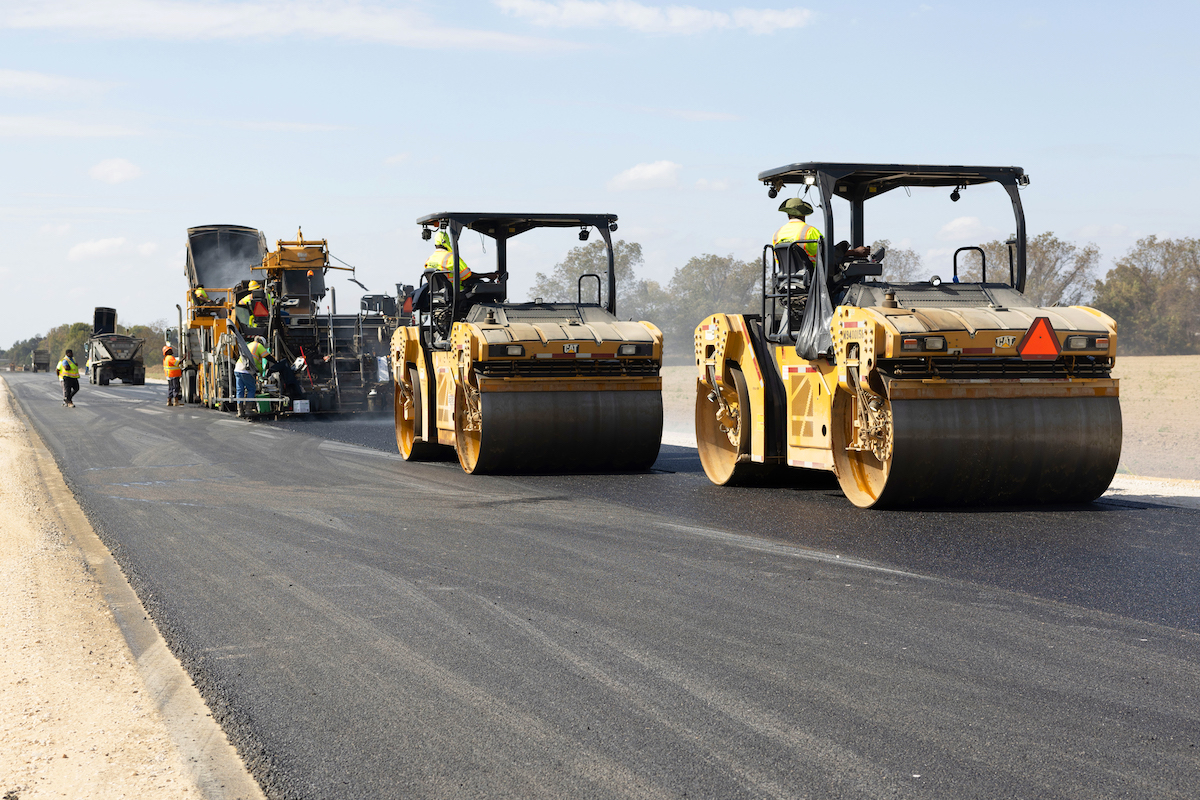If drivers happened to take the Cookingham/I-435 route during late summer 2019, they may have caught a glimpse of an impressive road construction project and some never-before-seen equipment. The construction site was home to a 24-foot-wide, 1,000-pound rolling tube of steel. And it was a real head-turner.
Sedimentary dirt and debris filled the south side of the ditch and the on-ramp. As the ditch filled up with sediment and dirt carried by the runoff, the material would spill over onto the south lane of the on-ramp. This presented slippery, dangerous situations for drivers heading for the interstate at 55 to 60 mph. To combat the issue, MoDOT maintenance crews used heavy-duty equipment to tackle the buildup, closing the on-ramp every few years to clear the ditch and roadway with skid steers, track hoes and several haul trucks. Last time they cleaned it, they shut down the on-ramp for two days to complete the cleaning. This method solved the problem temporarily but created headaches for drivers and a lot of unnecessary work for crews.
MoDOT tried incorporating pre-shaped paved flumes to carry the rainwater, but the flumes filled up just as quickly as the unpaved ditch and required just as much cleaning. MoDOT contemplated installing a rock-based lining, but research showed the quickly accumulating rainwater would likely carry the rocks away.
MoDOT continued to search for a viable solution to address the maintenance problem and finally found a permanent answer as part of a large concrete patching job on the roadway.

| Your local ASV dealer |
|---|
| CLM Equipment Co |
Stark, who has worked for Realm for more than 11 years, needed to find a solution that would stay within the budget and the assigned timeframe. The mission was to essentially line the ditch with concrete, and Stark initially only knew of one conventional method to accomplish it.
That method was to form the ditch in a sectional approach. This could be done either by pouring the bottom concrete and pulling a tube or screed up by hand, or pouring it transverse – coming down the slope to the bottom and then back up. Crews would pour one 20-foot bay, skip a 20-foot area, pour another 20-foot bay and so on. The next day, after the bays dried, crews could fill in the alternating empty areas. While this method is inexpensive and proven, it is time consuming and physically taxing.
“If we approached this project the conventional way, we’d only be able to pour about four bays a day, which is 80 feet of ditch liner a day,” Stark said. “At that rate, the project would have taken us 15 to 20 days. I knew we could do it quicker than that.”
Stark’s ultimate solution would include an approach that might end up with a higher initial equipment cost. But could that additional investment in equipment end up saving him time and money?
Stark proposed commissioning a large metal flume drum from Curb Roller Manufacturing. The company is known for their hydraulic- and battery-powered concrete roller screeds, but also manufactures custom-sized rolling drums. The drums are commonly used for pouring streets, medians, v-gutters or flumes, and while the company prides itself on creating custom solutions, this drum exceeded the size of any created in the past.

| Your local Hitachi dealer |
|---|
| CLM Equipment Co |
“I had seen a ditch liner drum on a different project a year prior and asked the contractor – Clarkson Construction – who made it,” Stark said. “It was only about 14 feet wide and I knew we’d need something nearly double that size. But I thought it could work.”
Curb Roller Manufacturing – based out of Fairview, Kansas – has been serving all industries from landscapers to government entities for more than 10 years. When Realm Construction approached them with the custom request, they were eager to engineer a solution.
The contractors were also ready to begin the project, but delivering an oversized custom drum to a jobsite had its obstacles. First, Stark had to get approval from MoDOT to implement this unique equipment and process. He presented his case, highlighting the potential for a better finished product and a significantly improved timeline.
Matt Daulton, MoDOT Resident Engineer for the project, reviewed Stark’s proposal and approved with one stipulation – using the Curb Roller couldn’t increase the overall cost of the project.
“We try to encourage innovation on every project,” Daulton said. “I had never seen something like this, but our contractors and manufacturers in the industry often have new ideas and the best answers, so we were open to it.”

| Your local Leica Geosystems Inc dealer |
|---|
| Laser Specialist inc |
After gaining clearance from MoDOT, Stark and his team had to work with the grading and excavation subcontractor who was preparing the ditch. The original design of the ditch, before implementing the Curb Roller idea, included varying widths and a flat bottom. This approach would save grading and excavating costs on a traditional concrete project, but the Curb Roller method would require a consistent width to successfully lay concrete. Stark was convinced that the extra cost in grading and excavating would make up for itself in the time savings down the line.
“I knew that this would create a more uniform product, which would be easier for MoDOT maintenance to clean out,” Stark said. “The original cross section of the ditch had varying slope widths and lengths through the entire 1,600-foot-long ditch liner. So we had to get the grading team to adjust and create a consistent canvas for the concrete.”
While the grading and excavating teams prepared the base, Stark worked with Curb Roller Manufacturing to design and craft the perfect flume drum.
“We had designed drums as long and as large in diameter, but never with this kind of combination,” Pyle said. “This was so impressive because it had such a large pan and slope wings. We know the capabilities of our product and we were confident taking on this challenge. We knew that with a few adjustments and alterations, we could pull this off and save the contractor time and labor.”
Stark officially submitted his order to Curb Roller Manufacturing: a 24-foot-wide, 1,000-pound hollow rolling flume drum. He calculated the required slope of the sides of the ditch according to MoDOT requirements. Each wing section of the drum was 8 feet wide, with an 8-foot flat pan section in the middle. The drum was 52 inches in diameter with 4:1 backslopes. Since the ditch liner itself is 2 feet deep, they achieved a 25-degree rise by implementing a 1-foot drop for every 4-foot run.

| Your local Takeuchi Mfg Ltd dealer |
|---|
| Kirby-Smith Machinery |
Pyle sent Stark a design of the product, which he promptly approved. The company delivered the drum to the jobsite just five days later.
Also onsite was a Takeuchi TL10 Compact Track Loader that provided hydraulic power for the spinning drum, as well as a Telebelt telescopic belt conveyor to place the concrete. The team modified the conveyor to lay the concrete in front of the tube.
They began pouring the concrete – a MoDOT hand-finished paving mix with a predetermined slump calculation.
“We were allowed to go to 5-inch slump, but we aimed for a 3.5-inch slump because of the slope,” Stark said. “We had more of a problem getting it too wet, which is ok because we just let it dry out.”
The wet concrete problem, which can be common on projects like this, wasn’t the only issue during the first day of pouring.

| Your local Wirtgen America dealer |
|---|
| Kirby-Smith Machinery |
“We got the flume all set up and moving it forward wasn’t a problem,” Stark said. “The only problem seemed to be related to the power source. The drum was binding up, but Kraig was on-site and he was determined to figure out a way to make it work efficiently.”
The team poured 60 yards and had to stop to address the power source.
“A very simple problem quickly became apparent,” Pyle said. “We had improperly sized the control valve to the upsized motor to handle the larger drum. This restriction in the smaller valve was causing the loader to overheat. A larger prototype valve we had in the works reduced the back pressure and restriction, alleviating the overheating that was happening.”
After Pyle figured out a solution for the power source issues, Stark and his team had to configure the dispersing of the material. This process presented its own set of issues.
“We tried placing the Telebelt chute right in front of the tube to move the material forward,” Stark said. “When it was right up against the tube like that, it ended up spraying the guys like crazy. We moved it ahead and found that the ideal spacing was about 6 feet ahead of the drum. This allowed the majority to be placed onto the bottom and the excess fed up onto the sides. Not only did this work better, but our guys were a lot happier because they didn’t go home looking like a sidewalk.”

| Your local Trimble Construction Division dealer |
|---|
| SITECH Tri-Rivers |
Once everything was dialed in and set to the perfect speed, distance and power, the Realm Construction team was on a roll. They poured 400 to 450 linear feet of concrete a day for the next three days, with virtually no roadblocks or issues. Despite the delays near the beginning of the project, they completed the project more than a week ahead of schedule.
If the crews had done the whole project by hand, there would have been an increased potential for neck, knee, and back injuries along the way. Since concrete work is already a physically taxing job, Curb Roller Manufacturing specifically designs products to get workers off their hands and knees into a more comfortable concrete pulling position.
Running the Curb Roller drum involved two workers pulling and guiding the drum, a few guiding the concrete to the correct place, and a few finishing the concrete with channel mops. While the drum is designed to bring the “cream and fat” to the surface and push aggregate down, it still required a final hand screed to seal the concrete.
By completing the project in essentially three pours, the team was not only able to save time and physical labor, they also created a higher-quality product. With a traditional method and many sections of concrete pours, dowels would have been required in each bay to tie them back to one another. While incorporating dowels creates a sturdy project, it’s certainly not as uniform or smooth as the three-pour approach with the Curb Roller.
“If they’d done this by hand, the quality and consistency goes way down,” Daulton said. “Since they did it in three large pours, it created a monolithic, uniform product.”

| Your local Yanmar dealer |
|---|
| CLM Equipment Co |
| WPI |
While there were additional costs throughout the project – purchasing the custom drum, renting the Telebelt, etc. – Stark says they still ended up under budget on the project.
“Everyone involved came out on top,” Stark said. “MoDOT got a higher-quality product in less time and with less traffic disruption. We saved time and money on the overall project, making it a more profitable venture. And Curb Roller had the opportunity to test the limits of their drums.”
“This was a real partnership, and we were more than pleased with the end result,” Daulton said. “We’ve worked with Realm Construction in the past, so I trusted their judgement when Russ said he had a new idea. We got a better final product, and they were able to decrease their cost and share some of that with us.”
The MoDOT maintenance team perhaps benefits most from the final product, since it makes their cleanup efforts a much simpler job. The team uses a skid steer to clear the ditch after every significant rainfall, and best of all it doesn’t require any lane closure or traffic disruption.
The project showcased everyone’s ingenuity; it highlighted MoDOT’s judgement, the contractor’s ability to think outside the box, and the manufacturer’s high-quality product. All parties agree, this project was a win-win-win.

| Your local Komatsu America Corp dealer |
|---|
| Kirby-Smith Machinery |
| WPI |





































































